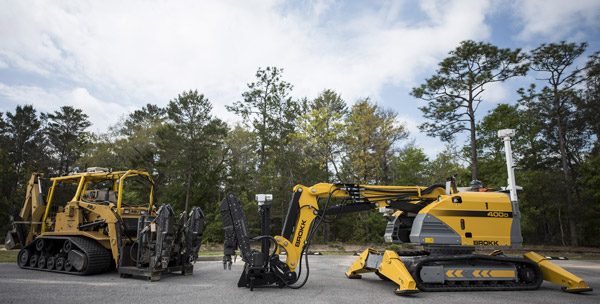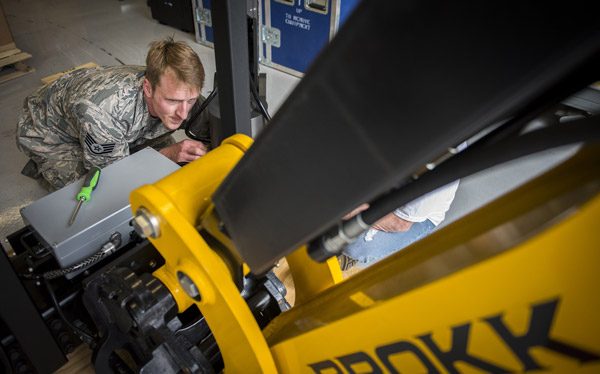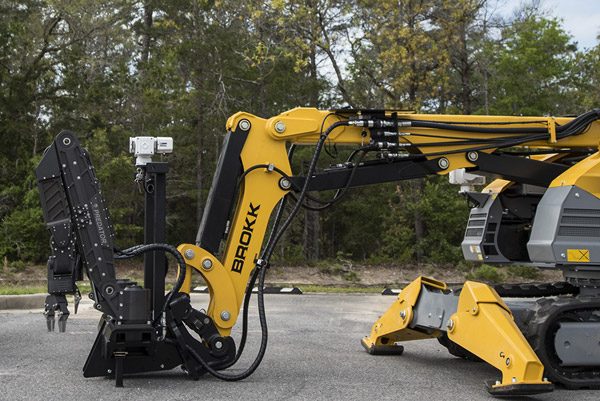The custom robot will support Eglin’s Test and Training Complex missions. This robotic system gives EOD technicians the ability to recover and dismantle munitions, which is key in aiding test engineers in weapons development.
EGLIN AIR FORCE BASE, Fla. — Pride and excitement were in the air at the 96th Civil Engineer Group’s explosive ordnance disposal robotics section as Airmen worked with contractors to assemble their newly designed robot here April 9.
The new, more powerful robot, currently dubbed Brokk after the Norse blacksmith who forged Thor’s hammer, replaces Stewie, an aging first-generation technology robot.
The custom robot will support Eglin’s Test and Training Complex missions. This robotic system gives EOD technicians the ability to recover and dismantle munitions, which is key in aiding test engineers in weapons development.

“This one [Stewie] has exceeded its life expectancy. It’s on its last leg and we need this capability,” said Maj. Kelly Mattie, EOD flight commander. “We put our heads together to work out an acquisition strategy and here we are, not quite a year and a half later and it [robot]rolled out.”
The $1.3 million acquisition is the only one of its kind in the world due to the various technological platforms incorporated into something new, the Brokk, according to Mattie.
Eglin’s EOD unit is also unique. It’s the only EOD unit in the Air Force with a test mission directive. They must have the capability to remotely remove weapon fuzes and data packages from live munitions to support the research, development, test and evaluation conducted here.
Seventh-generation telerobotic technologies from Kraft and Brokk machinery were combined to create the new platform. These machines are typically used for construction and in the demolition of the interior of small buildings.

“Nobody has adapted it to do what we plan to use it for,” said Mattie. “It’s smoother, faster and gives a lot of time back to the range users,” he said. “Instead of takings days to recover a test item – it may only take us four hours.”
On the range, when munitions hit the target towers, there is concrete, steel and debris in the area. To gain access to the bomb, a robot with a grapple attachment must remove the debris.
“Imagine something dropping from the sky and hitting the grass. With that kind of force and speed, it’s going to go into the ground 10, 20 or 30 feet, some times more,” said Mattie.
When that happens, EOD technicians use the robot to recover the test item.
To help EOD in these situations, one of the new additions is a concrete breaker with the ability to break through concrete-reinforced test targets to gain access to the munitions. Other attachments include giant shears that can cut through steel I-beams and rebar, a jack hammer and an excavator, which will double their digging capacity.
Another capability is the human-like dexterity of the force feedback manipulator arms that perform maneuvers for the delicate and risky task of rendering ordnance safe more smoothly with seamless transitions.
“The new arms can pickup an egg without crushing it. It’s human-like when it grabs an object,” said Mattie. “The old robot was jerky and bounced around a bit.”
The robotics section’s Airmen predicted their future capability needs and incorporated them into the new design. They worked closely with the two companies to tailor the robot’s design to meet their needs and identified what worked and what didn’t.

“I’m very proud of my section. It wasn’t an easy task,” said Master Sgt. J. Adam Burke, EOD robotics section chief, about the set up and design of the new robot. “Those folks had a huge hand in the development and delivery of the new platform.”
Mattie expects the new robot to be in its early operational stages within the next six months.
Because the new robot incorporates the latest technology, it requires little maintenance and saves an average of $145,000 a year in maintenance, range expenses and services costs, according to Mattie.
“Less time performing maintenance on upwards of 12-year-old legacy items will free up our time for more training and give us more time to support the test mission,” said Burke.

![EOD gets a one of a kind robot [PHOTOS] niceville eglin air force base](https://niceville.com/wp-content/uploads/2018/04/eafb-eod-robot.jpg)









